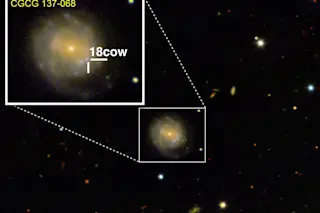Some 200 million years ago, not long after dinosaurs first appeared on Earth, a star collapsed in a nearby galaxy. The star’s collapse triggered an ultra-bright explosion that sent radiation racing across the cosmos. The light finally reached earthly skies this past summer, forming a strange, new beacon in the constellation Hercules.
The ATLAS survey’s twin telescopes in Hawaii, were the first to spot the exploding star on June 17, 2018. And astronomers from around the world – including an international team of 45 co-authors from 33 different institutions – soon turned their telescopes and attention to studying the mysterious compact object created in the aftermath. By combining radio waves, gamma-rays, and X-rays, the team suspects the object, officially named AT2018cow and informally called “The Cow,” is likely a black hole or neutron star surrounded by swirling stellar debris.
But the team still isn’t sure exactly what The Cow is. ...














